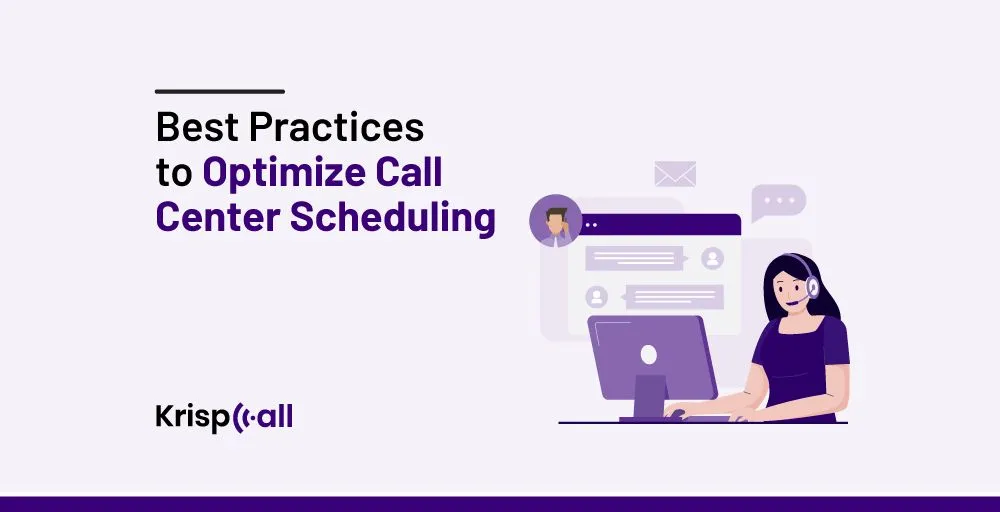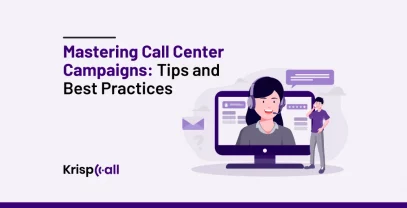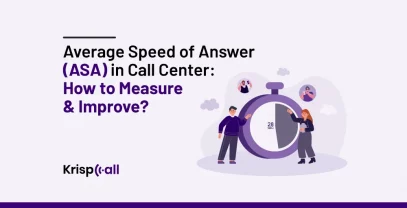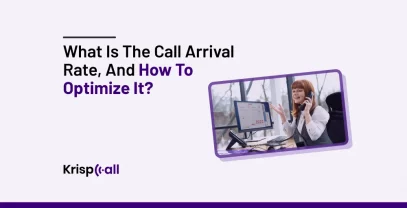When do you think is the best time to call customers🤔? The answer is when your customers want it😉.
Timing is critical when calling customers. Call center scheduling solves this problem by ensuring that customers receive calls at times convenient for their schedules.
In our increasingly fast-paced world🌎, where customers’ expectations are higher than ever, understanding call center scheduling is more crucial.
Therefore, this article will help you understand call center scheduling, how it works, and its importance. We will also explore how to optimize call center scheduling, the 5 best call center scheduling software, and factors to consider when choosing a call center scheduling software.
🔑 KEY HIGHLIGHTS
- Call center scheduling involves forecasting call volumes, determining staffing needs based on forecasts, developing employee shift schedules, offering flexibility, and utilizing technology to assist with scheduling.
- Setting optimal call schedules helps customers receive help when needed, makes the most of employee skills and preferences, saves costs, satisfies employees, and optimizes resource utilization.
- Key considerations for scheduling include adhering to SLAs, cross-training agents, real-time monitoring and adjustments, offering flexible options, utilizing advanced forecasting, prioritizing feedback, and supporting omnichannel communication.
- Top call center scheduling software automates scheduling, integrates with other systems, provides reliable forecasts, offers customizable features, and provides robust analytics and support.
- Talkdesk, RingCentral, Workforce.com, NICE CXone, and Assembled are the 5 best call center scheduling software.
- When choosing software, factors to evaluate are additional workforce options, customer reviews, integration capabilities, costs, mobile apps, ease of use, customer support levels, and data security and reliability.
What Is Call Center Scheduling?
Call center scheduling is a call center workforce management (WFM) activity that uses past data, predictive analysis, and forecasting to optimize employee schedules, determine appropriate staffing levels, and prepare for variations in call volumes. These scheduling solutions help call centers meet customer needs, increase business efficiency, and balance agent workloads.
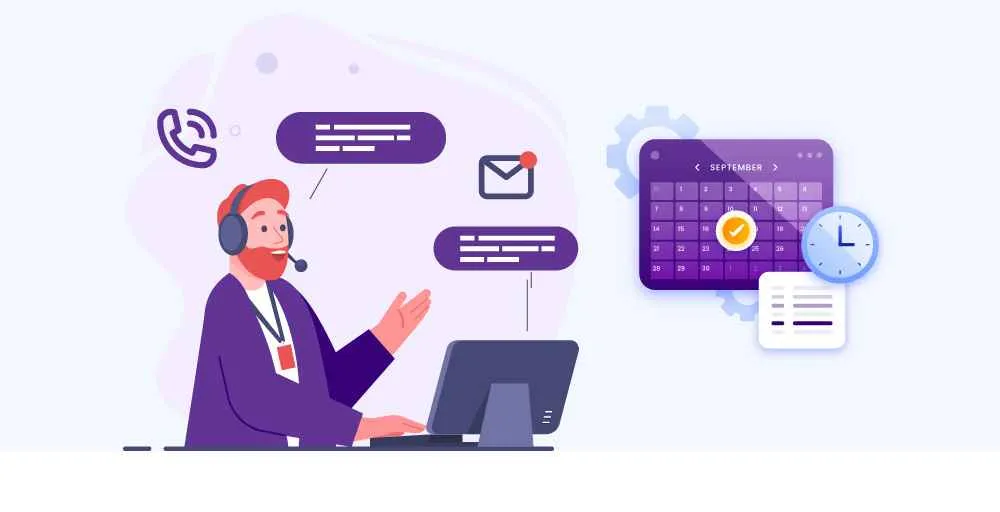
Moreover, Call center scheduling ensures sufficient staff is available to work during specific times or days. If enough workers aren’t scheduled to work at a given time, customers may become irritated by lengthy wait periods. Conversely, if too many agents are scheduled for a time, companies risk paying employees for shifts that weren’t truly necessary.
As such, it is important to utilize modern call center management methods to balance optimal staffing levels and minimize undesirable outcomes like customer dissatisfaction or wasted labor costs.
How Does Call Center Scheduling Work?
Call center scheduling involves carefully handling and structuring the staff to guarantee ideal personnel levels and effective operations. It generally consists of the following important steps:
1. Forecasting
Call centers analyze information and previous call trends to forecast when they will receive the highest volume of calls. For instance, Mondays may experience heavier call traffic than Fridays, or there could be spikes surrounding the lunch hour. Data is used to anticipate patterns in call volumes throughout different times and days.
2. Staffing Needs
Using the forecasts, call centers determine the appropriate number of staff required during varying times of the day or week to manage the anticipated quantity of calls. The predictions help inform staffing decisions and resource allocation to match workflow needs.
3. Shifts And Schedules
To address these projected busy periods, employees are assigned shifts. Some may work morning hours, others afternoons, and some evenings. Developing call center shift schedules allows businesses to streamline their phone processes and improve productivity by strategically allocating appropriate staffing levels based on anticipated call volumes across shifts.
4. Flexibility
Call centers frequently utilize systems that enable staff to exchange shifts when necessary. This offers flexibility if an employee becomes ill or there is an unforeseen surge in call volume. The shift swap functionality assists operations in adapting to changing circumstances.
5. Technological Assistance
Advanced CPaaS (Communications Platform as a Service) solutions such as IVR (Interactive Voice Response), virtual phone numbers, outbound dialing, auto-dialers, etc., help businesses effectively schedule calls. These technologies help track employee attendance, manage break times, and ensure appropriate shift coverage levels through features that monitor staffing levels and call volumes. The solutions support optimized call center scheduling.
6. Adapting To Changes
At times, the real number of calls may vary from forecasts. Call centers require flexibility to adapt staffing promptly. If call volumes surge beyond expectations, they could request that employees stay later, arrive earlier, or even bring in additional support. Adjusting resourcing dynamically helps ensure quality service when predictions differ from actual call volume on a given day or shift.
7. Balancing Workload And Rest
Call centers must equitably distribute workloads so staff do not become overwhelmed. They generally implement guidelines surrounding the maximum consecutive hours an employee can be scheduled and ensure breaks are provided. Properly managing workloads and providing sufficient rest helps prevent burnout among customer service representatives.
Importance Of Call Center Scheduling
Setting work schedules for call centers might seem basic, but it helps companies in significant ways. Here are 5 importance of call center scheduling:
- Making sure customers get help when needed: The number of calls coming into a call center changes a lot during the day, week, and seasons. By looking at past numbers and guessing what calls will be like in the future, the scheduling managers can plan to have enough workers taking calls during the busiest times.
- Getting the most from each worker: Good schedules prioritize what each worker is good at and prefers. This lets the scheduling get the most done by giving the right tasks to the right people.
- Saving money: Bad scheduling sometimes leads to too many workers and not enough at other times. Good scheduling aims for the right balance of workers each time. That way, the call center has exactly what it needs without wasting money. Proper scheduling allows the call center to operate at a lower cost, which is better for business.
- Satisfied Workers: When schedules consider agent availability and free time, they feel better about their jobs. Fewer people quit, which saves money from constantly training new hires. Happy agents do their best work so customers are treated well and the business avoids re-training costs.
- Optimal Resource Utilization: Planning call times helps ensure smooth operation. It prevents last-minute meetings that could cause problems. Based on the scheduled calls, managers can assign workers the right tools and teammates. Organized scheduling ensures that the call center’s people and equipment are utilized most effectively.
10 Best Tips To Optimize Call Center Scheduling
Optimizing call center scheduling enhances efficiency, customer service, and agent productivity. Here are 10 best tips to maximize call center scheduling:
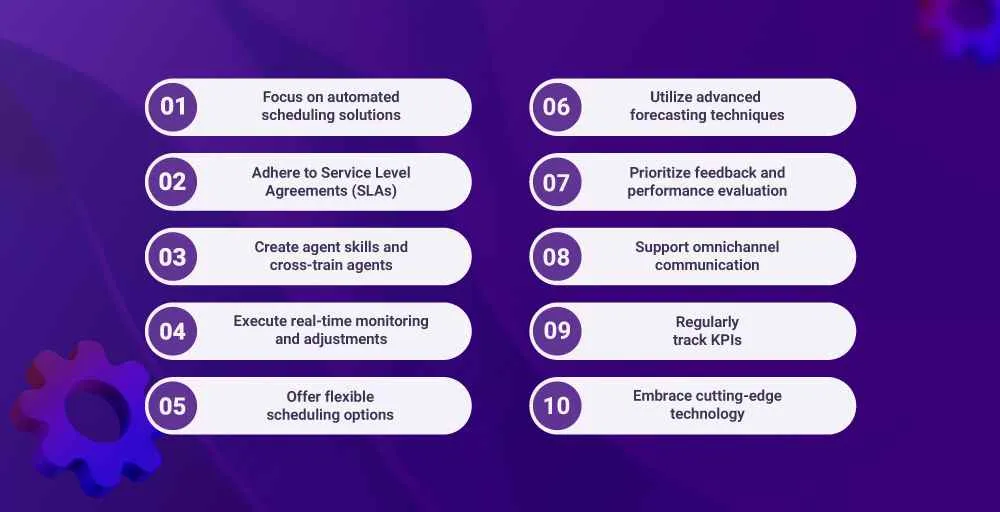
1. Focus On Automated Scheduling Solutions
Traditional methods of making schedules take a lot of time, often have errors and frequently struggle to assign the right people. However, using advanced call center software for scheduling is important for working efficiently.
This type of software uses algorithms to study call patterns, employees’ work times, and their skills. It then builds optimized schedules on its own. By not having people do it by hand, companies can simplify procedures, save money, and be sure that the correct staff are working.
Plus, these programs let you track how things are going and get useful data. The software handles it all, which means better control over the call center, allowing quicker changes when needed. It makes operations run smoothly and responsively.
2. Adhere To Service Level Agreements (SLAs)
Call centers need to align their scheduling with predefined SLAs. Establishing service-level agreements allows call centers to meet customer expectations consistently and avoid legal hassles and service disruptions.
Meeting these benchmarks consistently through strategic staffing builds trust that issues will be addressed satisfactorily. This trust promotes loyalty and positive word of mouth.
SLAs also provide recourse if the standard is not met. Falling short may constitute a penalty or refund as per the SLA. However, the priority is to avoid this through responsible planning. Call centers can first demonstrate their commitment to excellence by determining their obligations.
3. Create Agent Skills And Cross-Train Agents
Call center managers can set up filters to show each employee’s work area, completed training, language, and time zone. When making a schedule, always ensure each shift includes someone with each filter.
Providing employees with training sessions on various call center duties and job needs is also good. This makes them flexible enough to work on different call lines, work teams, and schedules. Cross-training gives managers more options when assigning shifts.
Schedules should be optimized to allow as much cross-training and flexibility as possible. This helps the call center be prepared for unseen situations, such as higher-than-usual call volumes on certain days.
4. Execute Real-Time Monitoring And Adjustments
To keep call center scheduling working well, you must monitor changes and new developments. Real-time monitoring features help managers see important information like the number of calls, the length of people’s wait, and the quality of agents’ work.
Looking closely at these numbers allows for finding problems, using resources efficiently, and fixing schedules when needed.
Plus, predictive analysis and forecasting tools can predict what will happen later by looking at past trends. This allows adjusting the number of employees who work before the new period starts. Foreseeing demand means better customer service during busy times.
5. Offer Flexible Scheduling Options
Offering flexible scheduling options is an important part of call center workforce management. It facilitates part-time jobs, split shifts where employees work some hours in the morning and others in the evening, and jobs where people can work from home.
A variety of scheduling choices enhance agents’ work-life balance. Split shifts may suit parents with school-aged kids, and those caring for elderly family members can more easily address duties during split shifts. Part-time hours adapt well for students or those with other obligations, making being an agent viable for more people.
Offering flexible scheduling also empowers employee loyalty and morale. Agents feel appreciated when a company understands individual circumstances and tries to adapt.
6. Utilize Advanced Forecasting Techniques
A call center must predict how many calls will arrive and when to make the best schedules. Instead of just guessing, centers should use complex calculating methods called advanced forecasting techniques.
These techniques analyze past patterns and combine them with other details, like what days of the week are busiest or if certain holidays mean more calls. They may also factor in outside influences impacting call volume, like weather or special sales.
By incorporating many specific data points, these advanced techniques give a clearer picture of what to expect each week or day. They help ensure the schedule has enough agents staffed during peak times but not too many sitting idle during other periods.
7. Prioritize Feedback And Performance Evaluation
Consistently checking how agents do their jobs and asking for their thoughts can help identify areas for improvement in scheduling and each individual’s work. Examining results and opinions provides facts to guide choices and tweak processes.
Gathering regular performance metrics and feedback is important for continual refinement. What helps now may not help in the future as conditions evolve. Re-evaluating exposes evolving challenges before they exacerbate.
Seeking employee perspectives is also particularly valuable. Agents have first-hand experience with schedules and customer interactions. Their insights on optimal hours or task barriers provide a view executives cannot replicate. An evaluate-and-improve cycle using metrics and feedback drives lifelong performance optimization.
8. Support Omnichannel Communication
Combining different communication methods into one system makes it easier for customers and agents. Omnichannel communication allows all employees to see customer profiles and past conversations on any call, chat, or message.
Integrating multiple contact methods enhances the omnichannel customer experience. Customers don’t have to repeat information when switching between phones, websites, apps, etc. Agents can see the full history, so no details get lost. This unified view gives a complete picture to provide top-notch assistance.
It’s also beneficial for business goals. Automating simple inquiries cuts back on long hold times, and customers turn to alternative options instead of waiting on hold. This helps keep service levels high during hectic periods.
9. Regularly Track KPIs
Even after the best schedules are used, monitor important numbers to see how things change. Monitor what agents and customers do and adjust shifts based on new trends. Try different methods for predicting what will happen and measure things from different angles for a full picture of the call center’s performance.
Staying aware of shifts allows prompt reaction to avoid issues. If wait times start rising, agents may need more training or support on specific topics. Busier days could require scheduling additional staff. Catching changes early through constant oversight prevents problems from escalating.
Customers will experience consistent, high-quality service as schedules synchronously update to current trends. Over time, this cyclical adjustment keeps the operation running smoothly.
10. Embrace Cutting-Edge Technology
When call center schedule software works with other programs, like CRM tools, scheduling runs smoother. Connecting scheduling software to systems for relationships with clients (CRM) and workforce oversight lets data move easily between programs.
It lets reports make themselves and coordinates what the different parts do—like how forecasting predicts needs and scheduling fills them. Bringing related technologies together harmonizes operations and streamlines processes.
Seamless data flows between scheduling and other systems save valuable time. Managers don’t spend hours manually transferring numbers between programs. This fluid integration frees up more hours to analyze insights and improve strategies.
5 Best Call Center Scheduling Software
Knowing the best software is important for implementing call center scheduling software. Here are 5 best call center scheduling software:
1. Talkdesk
Talkdesk is a commonly used program for making call center schedules. It has great tools for managing all the employees. Some cool features help automatically make the perfect schedule without much manual work. The self-predicting aspect forecasts how many calls to expect so schedules can be tailored to meet demand.
Manual scheduling takes a long time, but Talkdesk automates most of it. Agents can be scheduled based on predicted call volumes and their skills/availability without as much back-and-forth adjusting. It optimizes allocating tasks and projects to employees without human micromanaging each detail.
🌟 Key Features
- Accurate forecasting
- Agent Scheduling and Assignment
- Persistent Data
- Agent bots
- AI tools
✅ Pros
- Workers can easily switch between office and home without messing up call handling.
- The automatic call routing gets customers to the correct agents fast.
- AI self-help is always available, so people can get support whenever they want.
❌ Cons
- The reports just give basic info, not specific details.
- It’s hard to see contact details in real-time, which affects call quality.
💰 Talkdesk Pricing
- CX Cloud Digital Essentials – $85 per user per month
- CX Cloud Essentials – $85 per user per month
- CX Cloud Elevate – $115 per user per month
- CX Cloud Elite – $145 per user per month
- Experience Clouds – Custom industry packages
2. RingCentral
RingCentral is a well-known program that creates call center schedules. It helps managers assign the right number of workers based on the number of calls and the available employees. RingCentral has tools like automated phone trees, text understanding, and call routing. These features direct customer calls to the agent best suited to help.
Sending people to the correct helpers allows RingCentral to make the call center smoother and save money. RingCentral boosts efficiency, so fewer staff are needed, reducing payroll costs. It helps contact centers cut expenses while getting more done simultaneously.
🌟 Key Features
- Call from computer softphone
- Call flip
- Hot desking
- IVR
- Multi-way conference call
✅ Pros
- RingCentral works on phones, tablets, and computers, so remote workers can all be managed from anywhere.
- Making the program handle more people is simple since new agents can be added quickly.
- The customer service reps are very helpful and quick to answer technical questions.
❌ Cons
- Call audio needs to improve since calls sometimes drop if the internet is slow.
- The prices aren’t very flexible, and changing or renewing plans is difficult.
💰 RingCentral Pricing
- Essentials plan: $19.99 per user per month
- Standard plan: $27.99 per user per month
- Premium plan: $34.99 per user per month
- Ultimate plan: $49.99 per user per month
3. Workforce.com
Another good call center scheduling program is Workforce.com. It combines workforce management with payroll processing into one tool. This is helpful because it can forecast the number of agents needed for each shift based on call lengths and numbers.
The software analyzes data insights to determine which shifts require more or less staffing. Having workforce management and payroll together streamlines assigning workers and paying them accordingly. It also makes staffing decisions easier by considering details that influence how many people are needed at any time.
🌟 Key Features
- Schedule Management
- Performance Tracking
- User Role Access
- Employee Information Automation
- Integrations
✅ Pros
- The home screen, monitoring, and planning tools can be changed to fit specific needs.
- Agents can easily save and find important data later using bookmarks.
- Workers can watch their shifts and request time off directly through the program.
❌ Cons
- The geotag feature that tracks location needs technical improvements to work as wanted.
- Sometimes, the app takes a while to start up; errors can happen when logging hours.
💰 Workforce Pricing
Workforce.com pricing varies depending on your requirements. Contact their sales team to request a quote.
4. NICE CXone
NICE CXone is a widely used program for managing employees that uses artificial intelligence to predict workforce needs and machine learning to make schedules. Since the process is automated, companies can easily adjust staffing without much manual work.
The precision of its predictions and scheduling choices gets better when it tests out different possible situations. This allows management to consider various scenarios to determine the optimal staffing plan based on how reality might unfold.
🌟 Key Features
- AI/Machine Learning
- Concurrent Calling
- Mobile Scheduling
- Scenario Modeling
- Intraday Forecasting
✅ Pros
- Employees can easily keep track of their time off using the time off manager part.
- Since it uses a complex math formula, the predictions are more right than other programs.
- Setup and organizing the starting data can be done automatically.
❌ Cons
- It takes a lot of time to get used to since there’s a big learning curve.
- The look feels old and needs a refresh with new features.
💰 Nice CXone Pricing
- Essential suite- $135 per month
- Core suite – $169 per month
- Complete suite – $209 per month
5. Assembled
Assembled is a powerful call center program that assists with staffing choices and oversees performance for both in-house and outsourced call centers. It optimizes employee usage by generating schedules based on data and provides a combined look at the team’s results.
The statistics and planned shifts can be imported or exported as a CSV file with only a few mouse clicks. This makes it simple to view or transfer the workforce information. Creating schedules guided by numbers and monitoring overall success enables Assembled to help contact centers use their staff most effectively.
🌟 Key Features
- Labor Forecasting
- Absence and Leave Management
- Shift Scheduling
- Integrations
- Multi-channel Forecasting
✅ Pros
- Since it bases predictions on numbers, Assembled helps companies make important long-term choices.
- Workers’ schedules automatically show in Google Calendar, so less manual syncing and chatting is needed.
- The reports provide a lot of useful stats that support good decision-making.
❌ Cons
- The data displays take a bit longer than expected.
- Assembled doesn’t partner well with many HR programs, so employees must request time off in two separate spots.
💰 Assembled Pricing
Assembled pricing varies depending on your requirements. Contact their sales team to request a quote.
Factors To Consider When Choosing A Call Center Scheduling Tool
When picking a call center program with workforce and scheduling tools, think about the following:
- Additional workforce and scheduling options: Consider extra functions like time tracking for tasks, custom rules for making schedules, built-in rules for laws or training, managing paid time off, hiring and onboarding, reports on employee work and scorecards, and manager dashboards.
- Customer reviews: Look for popular good and bad points about the program mentioned often, any differences between posted prices and real costs, and how the company addressed user concerns in reviews.
- Integration with Other Programs: Make sure the call center scheduling tool works smoothly with existing CRM software, support tech programs, marketing tools, and team chat/workflow programs already in use.
- Cost: Explore flexible price levels with options to add more features, lower costs for high-volume or single-company users, pay per employee used, or pay only for what’s needed each month.
- Phone App: Look for tools with a fully functional app for Android and Apple devices that allows customized updates to be sent in real-time, bidding on shifts, scheduling reminders, managing time off, and more.
- Simple to Use: The call scheduling tool should have an intuitive setup with customizable home screens depending on user role, drag-and-drop reporting that includes automatic analysis, and color-coded scheduling.
- Customer Support: Customer support must be available all day, every day, through several options like phone, email, or chat. Larger businesses should also receive paid support upgrades, with onboarding guidance like online training sessions, tutorials, and a searchable help page.
- Reliability and Privacy: Check if the tool provides customized options for keeping data, following HIPAA/GDPR compliance, information encryption, server backups in multiple locations for 99.9% up-time, multi-factor authentication, and non-stop network oversight.
Conclusion
A well-planned and optimized call center scheduling system is crucial for any business that relies on customer service. It helps you provide pleasant customer service and keep your customers happy. Proper scheduling ensures efficient resource allocation to meet customer needs and improve the customer experience through high FCR (First Contact Resolution).
Furthermore, call center scheduling helps you run your customer service operations as efficiently and effectively as possible, which will pay off big time in terms of satisfied customers, happy employees, and a healthier bottom line for your company.
FAQs
What are common challenges in call center scheduling?
The common challenges in call center scheduling are:
- Unpredictable call volumes
- Balancing staff availability and preferences
- Meeting service level agreements (SLAs)
- Agent burnout and attrition
What features should you look for in call center scheduling software?
The features that you should look for in a call center scheduling software are:
- Shift Management
- Real-Time Monitoring
- Forecasting and Planning
- Agent Management
- Reporting and Analytics
What is schedule adherence in a call center?
Schedule Adherence is an important call center metric that measures whether agents adhere to their assigned schedules.

